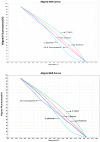Detection of Leishmania spp. in Cats: Analysis of Nasal, Oral and Conjunctival Swabs by PCR and HRM
- PMID: 37570277
- PMCID: PMC10417458
- DOI: 10.3390/ani13152468
Detection of Leishmania spp. in Cats: Analysis of Nasal, Oral and Conjunctival Swabs by PCR and HRM
Abstract
Background and objectives: Feline leishmaniasis (FeL) is caused by several species of parasites of the genus Leishmania. The disease can occur with the presence or absence of clinical signs, similar to those observed in other common infectious diseases. In endemic regions for FeL, the infection has been associated with dermatological lesions. Therefore, considering the search for less invasive and more effective diagnostic techniques, we aimed to investigate the presence of Leishmania spp. in domestic cats through Polymerase Chain Reaction (PCR) and high-resolution melting (HRM) analyses of conjunctival, oral, and nasal epithelial cells, and we detected the presence of anti-Leishmania IgG antibodies from serological techniques of the Immunofluorescent Antibody Test (IFAT) and ELISA.
Methods: The PCR and HRM for detection of Leishmania spp. were performed on 36 samples of epithelial cells from the conjunctiva of male and female cats, collected using sterile swabs. The serological tests IFAT and ELISA were also performed.
Results: The prevalence of Leishmania donovani infection was 11.1% (4/36) by PCR assay, and those results were confirmed for Leishmania species using the HRM technique. Twenty-four cats (24/36 = 66.7%) were reactive to the IFAT and twenty-two cats were reactive by the ELISA technique (22/36 = 61.1%).
Interpretation and conclusions: The use of conjunctival swabs was shown to be a non-invasive, practical, and easy-to-perform technique, and in addition to the genetic sequencing and HRM, it was able to identify the parasitic DNA of L. donovani in cats. This technique can be used for screening diagnosis in future epidemiological surveys of FeL and can be used as a complement to clinical and/or serological tests, as well as associating the clinical history of the animal, for the diagnostic conclusion.
Keywords: HRM; PCR; cats; conjunctival swabs; feline leishmaniasis.
Conflict of interest statement
The authors declare no conflict of interest.
Figures
References
-
- World Health Organization Leishmaniasis. 2022. [(accessed on 3 October 2022)]. Available online: https://www.who.int/health-topics/leishmaniasis#tab=tab_1.
LinkOut - more resources
Full Text Sources
Miscellaneous


